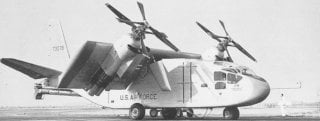The Experimental Cold War Aircraft That Inspired America’s V-22 Osprey Tiltrotor
Though unsuccessful, the plane was not in vain.
Here's What You Need to Know: Though unsuccessful, the X-18’s purpose as medium-range transport was resurrected in the late 1980s and 1990s with the development of the V-22 Osprey
The X-series of planes was a series of experimental research aircraft developed mostly by NASA and the U.S. Air Force to explore flight characteristics of new airframe designs. In the late 1940s and 1950s, the X-series planes played a crucial role in evaluating untested designs. Virtually all American aircraft benefit is some way from the data generated by the X-series.
The V-22 Osprey tiltrotor is one of the United States Marine Corps’ most recognizable platforms. The V-22 can hover like a helicopter or fly like a turboprop thanks to its vertical take-off and landing (VTOL) capabilities. The V-22 simplifies logistics for the Marine Corps and is able to fly in an out of locations on land and at sea that other aircraft are unable to access.
Hiller X-18
Hiller Aircraft Corporation designed the 16.5 ton X-18 as a medium-range transport. The X-18 was designed to take off from short, austere runways when needed by combining the hover and lift capabilities of a helicopter with the flight speed and range of a turboprop airplane. In order to keep the prototype’s costs low, and to speed production, the Hiller Corporation scavenged a number of parts from other existing or prototype aircraft.
One of the more important parts take from other airframe designs were the two rather large contra-rotating propellers, similar to those seen on the Russian Tu-95 bomber. Contrarotating propellers benefit from increased efficiency when compared to normal propellers, though they tend to be significantly louder.
The particular propellers used in building the X-18 were taken from two odd-looking planes—that were also early experimental testbeds for vertical take-off and landing. One of these strange designs, the XFY Pogo, was unsuccessful as a V/STOL fighter plane, though it successfully completed a number of test flights.
The Hiller X-18 was a tiltwing design in which the entire wing rotates 90 degrees upwards during hover, and then slowly shifts downwards once proper altitude for forward flight is achieved. This feature was one of the shortcomings of the X-18’s designs. During take-off, the wide wing acted like a ship’s sail. It was impractical and occasionally dangerous to fly during high-wind conditions though luckily no accidents occurred, according to NASA.
One of the V-22’s strengths is the fact that both its engines are linked to a single gearbox. In case of engine failure due to mechanical breakdown or damage sustained, the V-22 is able to fly on a single engine. In practice, this means that level flight is possible, though at lower performance than when both engines are engaged. The X-18 on the other hand was unable to fly either levelly or while hovering on just a single engine as its engines used separate gearboxes.
Postscript
All was not in vain. Though unsuccessful, the X-18’s purpose as medium-range transport was resurrected in the late 1980s and 1990s with the development of the V-22 Osprey—one of the beneficiaries of the X-18’s flight data. Thanks for the work, X-18.
Caleb Larson is a defense writer for the National Interest. He holds a Master of Public Policy and covers U.S. and Russian security, European defense issues, and German politics and culture.
This article first appeared in June 2020 and is being reprinted due to reader interest.
Image: Wikimedia Commons.

